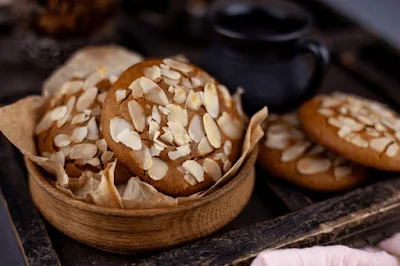Almond Flour Recipes for Beginners: Health Benefits, Low-Carb Ideas, and Easy Gluten-Free Baking Tips and recipes
Almond Flour Recipes: A Comprehensive Guide to Healthy Eating and Weight Loss
Almond flour is one of the most versatile and health-friendly ingredients you can add to your pantry. Whether you’re on a gluten-free diet, exploring low-carb options, or simply trying to eat healthier, almond flour offers incredible benefits. From its rich nutritional value to its low-carb profile, almond flour is a favorite among health-conscious bakers and cooks.
In this guide, we'll explore almond flour's benefits, its role in weight loss, and provide an extensive list of delicious recipes with detailed instructions to help you bring this ingredient to life.
Why Choose Almond Flour?
If you’ve ever wondered why almond flour is gaining popularity, here’s what makes it stand out:
- Nutrient-Dense: Almond flour is packed with protein, healthy fats, vitamin E, and magnesium. These nutrients promote skin health, boost metabolism, and support overall well-being.
- Gluten-Free and Grain-Free: For those with gluten sensitivities or following paleo and grain-free diets, almond flour is a natural alternative to wheat-based flours.
- Low-Carb and Keto-Friendly: Almond flour is a staple in low-carb and ketogenic diets due to its low glycemic index and reduced carb count.
- Rich, Nutty Flavor: It adds a unique, slightly sweet, nutty taste to recipes, enhancing both sweet and savory dishes.
Almond Flour and Weight Loss
One of the most appealing aspects of almond flour is its ability to support weight loss while still allowing you to enjoy delicious foods.
- High in Protein and Fiber: Almond flour is naturally high in protein and fiber, both of which are essential for weight management. Protein keeps you full and supports muscle growth, while fiber helps control hunger and improve digestion.
- Low Glycemic Index: Unlike refined flours, almond flour doesn’t cause sharp spikes in blood sugar levels. This makes it ideal for managing cravings and reducing overeating.
- Healthy Fats for Satiety: The healthy monounsaturated fats in almond flour provide long-lasting energy, keeping you full and reducing the temptation to snack on unhealthy foods.
- Low-Carb Powerhouse: For those following keto or other low-carb diets, almond flour is a fantastic substitute for high-carb flours. With only about 10 grams of net carbs per cup, it’s a guilt-free option for baking and cooking.
Tips for Using Almond Flour
- Adjust Liquids: Almond flour absorbs more moisture than regular flour, so you may need to reduce liquids in recipes.
- Mix with Other Flours: Combining almond flour with coconut flour can improve texture and balance.
- Bake at Lower Temperatures: Almond flour browns faster, so reduce oven temperature slightly to avoid burning.
- Use Binding Agents: Eggs, flaxseed, or xanthan gum can act as binders in almond flour recipes.
Delicious Almond Flour Recipes
1. Fluffy Almond Flour Pancakes
Ingredients:
- 2 cups almond flour
- 1 tsp baking powder
- 2 large eggs
- 1/3 cup almond milk (or any milk of your choice)
- 1 tsp vanilla extract
- 1 tbsp maple syrup (optional)
- A pinch of salt
Instructions:
- In a large bowl, whisk together the almond flour, baking powder, and salt.
- In a separate bowl, beat the eggs, almond milk, vanilla extract, and maple syrup.
- Gradually pour the wet ingredients into the dry ingredients, stirring until a smooth batter forms.
- Heat a non-stick skillet or griddle over medium heat. Lightly grease with butter or coconut oil.
- Pour 1/4 cup of batter onto the skillet for each pancake. Cook for 2-3 minutes, or until bubbles appear on the surface. Flip and cook for another 2 minutes.
- Serve warm with fresh berries, a drizzle of honey, or a dollop of yogurt.
2. Almond Flour Brownies
Ingredients:
- 1 cup almond flour
- 1/2 cup cocoa powder
- 1/2 tsp baking powder
- 1/4 tsp salt
- 1/3 cup coconut oil (melted)
- 2 large eggs
- 1/2 cup coconut sugar (or sweetener of choice)
- 1 tsp vanilla extract
Instructions:
- Preheat your oven to 350°F (175°C) and line an 8x8-inch baking pan with parchment paper.
- In a medium bowl, whisk together almond flour, cocoa powder, baking powder, and salt.
- In another bowl, mix the melted coconut oil, eggs, coconut sugar, and vanilla extract until smooth.
- Gradually add the dry ingredients to the wet ingredients, stirring until a thick batter forms.
- Pour the batter into the prepared pan and spread evenly.
- Bake for 20-25 minutes, or until a toothpick inserted into the center comes out with a few moist crumbs.
- Allow the brownies to cool completely before cutting into squares.
3. Almond Flour Pizza Crust
Ingredients:
- 2 cups almond flour
- 1/4 cup grated Parmesan cheese
- 1 tsp baking powder
- 2 large eggs
- 1 tbsp olive oil
Instructions:
- Preheat your oven to 375°F (190°C) and line a baking sheet with parchment paper.
- In a bowl, mix almond flour, Parmesan cheese, and baking powder.
- Add eggs and olive oil, stirring until a dough forms.
- Place the dough on the prepared baking sheet and flatten into a circle using your hands or a rolling pin.
- Bake for 10 minutes, then add your favorite toppings and bake for an additional 10 minutes.
4. Almond Flour Banana Bread
Ingredients:
- 2 cups almond flour
- 1 tsp baking soda
- 1/4 tsp salt
- 3 ripe bananas, mashed
- 3 eggs
- 1/4 cup honey or maple syrup
- 1 tsp vanilla extract
- 1/4 cup melted coconut oil or butter
- 1/2 cup chopped walnuts or chocolate chips (optional)
Instructions:
- Preheat your oven to 350°F (175°C) and line a loaf pan with parchment paper.
- In a bowl, whisk together almond flour, baking soda, and salt.
- In another bowl, mix mashed bananas, eggs, honey, vanilla, and melted coconut oil.
- Combine the wet and dry ingredients until smooth. Stir in walnuts or chocolate chips if desired.
- Pour the batter into the loaf pan and bake for 50-55 minutes, or until a toothpick inserted into the center comes out clean.
- Let the bread cool before slicing and serving.
5. Almond Flour Cookies
Ingredients:
- 2 cups almond flour
- 1/4 cup coconut sugar or sweetener of choice
- 1/4 tsp baking soda
- 1/4 tsp salt
- 1/4 cup coconut oil, melted
- 1 large egg
- 1 tsp vanilla extract
Instructions:
- Preheat your oven to 350°F (175°C) and line a baking sheet with parchment paper.
- In a bowl, combine almond flour, coconut sugar, baking soda, and salt.
- Add melted coconut oil, egg, and vanilla extract to the dry ingredients and mix until a dough forms.
- Roll dough into balls and place on the prepared baking sheet. Flatten each cookie slightly with your fingers.
- Bake for 8-10 minutes, or until the edges are golden brown.
- Allow the cookies to cool on a wire rack before serving.
6. Almond Flour Muffins
Ingredients:
- 2 cups almond flour
- 1 tsp baking powder
- 1/4 tsp salt
- 2 large eggs
- 1/4 cup honey
- 1/4 cup almond milk
- 1 tsp vanilla extract
- 1/2 cup blueberries or chocolate chips (optional)
Instructions:
- Preheat your oven to 350°F (175°C) and line a muffin tin with paper liners.
- In a large bowl, mix almond flour, baking powder, and salt.
- In another bowl, whisk together eggs, honey, almond milk, and vanilla extract.
- Combine the wet and dry ingredients and stir until smooth. Gently fold in blueberries or chocolate chips if desired.
- Divide the batter evenly among the muffin cups.
- Bake for 15-20 minutes, or until a toothpick comes out clean.
Conclusion
Almond flour is a versatile, nutritious, and gluten-free alternative to regular flour that has gained popularity for its numerous health benefits. Whether you're following a low-carb, keto, or gluten-free diet, almond flour is a fantastic option to enhance your cooking and baking. From pancakes and muffins to brownies and pizza crust, there are endless ways to incorporate almond flour into your meals, adding both flavor and nutrition. It is an excellent source of healthy fats, protein, and fiber, making it a great addition to your diet, especially if you're looking to manage weight or improve overall health.
As with any dietary change, it's important to experiment with recipes and find the best ways to incorporate almond flour into your meals. With its rich flavor and health benefits, you'll be able to create delicious, satisfying dishes that support your health and wellness goals. So, give almond flour a try in your next recipe and enjoy the tasty and healthy results!
FAQs About Almond Flour
1. Can I use almond flour for baking regular flour recipes? Yes, you can substitute almond flour for regular flour in many recipes, but you may need to adjust the quantity and other ingredients. Almond flour is denser and has more moisture, so recipes may require additional egg or liquid to help bind the ingredients together.
2. Does almond flour taste different from regular flour?
Almond flour has a distinct nutty flavor that adds a rich taste to baked goods. While it's not exactly the same as regular flour, it enhances the texture and flavor of many recipes, especially in gluten-free or low-carb versions.
3. Is almond flour good for weight loss?
Almond flour can be beneficial for weight loss due to its high protein and fiber content, which help keep you feeling full for longer. It is also lower in carbs than regular flour, which makes it a great option for people on low-carb or keto diets.
4. Can I use almond flour if I have a nut allergy?
If you have a nut allergy, almond flour is not suitable, as it is made from ground almonds. In this case, you may want to explore other flour alternatives such as coconut flour or rice flour.
5. Can almond flour be stored for a long time?
Yes, almond flour can be stored for a long time if kept in an airtight container in a cool, dry place. For longer storage, you can refrigerate or freeze almond flour to preserve its freshness for several months.









Comments